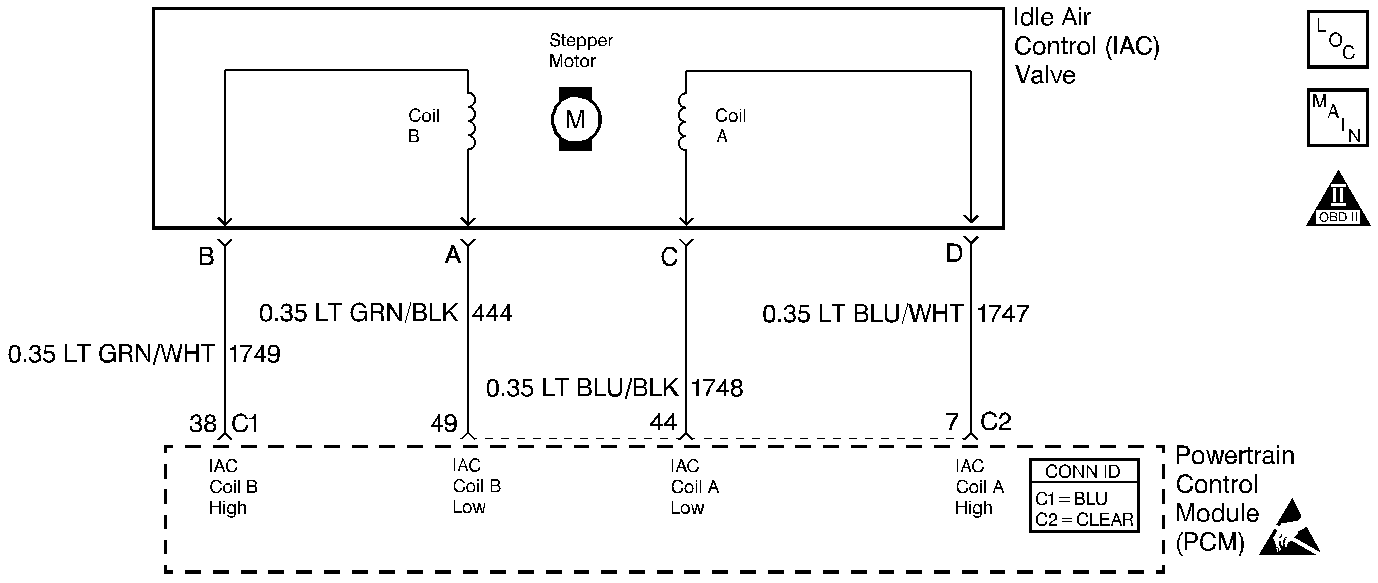
Circuit Description
The Powertrain Control Module (PCM) controls engine idle speed by adjusting the position of the idle air control (IAC) motor pintle. The IAC is a bi-directional motor driven by two coils. The PCM applies current to the IAC coils in pulses (counts) to extend the IAC pintle into a passage in the throttle body to decrease air flow. The PCM reverses the current to retract the pintle, increasing air flow. This method allows highly accurate control of idle speed and quick response to changes in engine load. If the PCM detects a condition where too low of an idle speed is present and the PCM is unable to adjust idle speed by increasing the IAC counts, DTC P0506 will set.
Conditions for Running the DTC
| • | No active TP, ECT, MAP, IAT, MAF, CKP sensor, EVAP, misfire, EGR, VSS, Fuel Trim, injector circuit, DTCs active |
| • | The Engine Coolant Temperature (ECT) is above 70°C (158°F). |
| • | The engine has been running for at least 2 minutes. |
| • | The system voltage is between 9.0-16.0 volts. |
| • | The vehicle speed is less than 4.8 km/h (3 mph). |
| • | The intake air temperature (IAT) is above -18°C (0°F). |
| • | The throttle is closed. |
| • | BARO is above 65 kPa. |
Conditions for Setting the DTC
| • | The Engine Speed is more than 175 RPM lower than Desired Idle. |
| • | The above condition is for more than 15 seconds. |
Action Taken When the DTC Sets
| • | The PCM will illuminate the malfunction indicator lamp (MIL) during the second consecutive trip in which the diagnostic test has been run and failed. |
| • | The PCM will store conditions which were present when the DTC set as Freeze Frame/Failure Records data. |
Conditions for Clearing the MIL/DTC
| • | The PCM will turn OFF the malfunction indicator lamp (MIL) during the third consecutive trip in which the diagnostic has run and passed. |
| • | The history DTC will clear after 40 consecutive warm-up cycles have occurred without a malfunction. |
| • | The DTC can be cleared by using a scan tool. |
Diagnostic Aids
Inspect for the following conditions:
| • | Poor connection at the PCM or IAC valve--Inspect harness connectors for: |
| - | Backed out terminals |
| - | Improper mating |
| - | Broken locks |
| - | Improperly formed or damaged terminals |
| - | Poor terminal to wire connection |
| • | Refer to Testing for Intermittent Conditions and Poor Connections and Connector Repairs in Wiring Systems. |
| • | Damaged harness--Inspect the wiring harness for damage. Refer to Wiring Repairs in Wiring Systems. |
| • | Restricted air intake system--Inspect for a possible collapsed air intake duct, restricted air filter element, or foreign objects blocking the air intake system. |
| • | Throttle body--Inspect for objects blocking the IAC passage or throttle bore, excessive deposits in the IAC passage, on the IAC pintle, in the throttle bore and on the throttle plate. |
| • | Large vacuum leak--Inspect for a condition that causes a large vacuum leak, such as a incorrectly installed or faulty PCV valve or the brake booster hose disconnected. Refer to Symptoms . |
If the DTC cannot be duplicated and is determined to be intermittent, reviewing the Failure Records can be useful in determining when the DTC was last set. Also refer to Testing for Intermittent Conditions and Poor Connections in Wiring Systems.
Test Description
The number below refers to the step number on the diagnostic table.
Step | Action | Values | Yes | No | ||||||||
|---|---|---|---|---|---|---|---|---|---|---|---|---|
1 | Did you perform the Powertrain On-Board Diagnostic (OBD) System Check? | -- | ||||||||||
2 | Are any other DTCs set? | -- | Go to the applicable DTC table | |||||||||
3 |
Does the Engine Speed remain within the specified value of Desired Idle for each RPM command? | ±50 RPM | Go to Diagnostic Aids | |||||||||
4 |
Does each node lamp cycle red and green (never off)? | -- | ||||||||||
5 |
Did you find and correct the condition? | -- | ||||||||||
6 | Visually and physically inspect for the following conditions:
Does any of the above require a repair? | -- | Go to appropriate section for on-vehicle service | |||||||||
7 |
Did you find and correct the condition? | -- | ||||||||||
8 | Replace the IAC valve. Refer to Idle Air Control Valve Replacement . Did you complete the replacement? | -- | -- | |||||||||
9 |
Did you find and correct the condition? | -- | ||||||||||
|
Important: : The replacement PCM must be programmed. Replace the PCM. Refer to Powertrain Control Module Replacement/Programming . Did you complete the replacement? | -- | -- | ||||||||||
11 |
Does the Engine Speed remain within the specified value of Desired Idle for each RPM command? | ±50 RPM | System OK |
